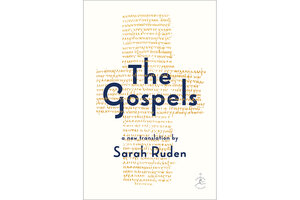‘In the Gospels, no one is essential but Jesus’: new translation adds fresh scholarship
Some of Sarah Ruden’s choices offer a refreshing break from the familiar versions of the past. Others don’t quite work.

"The Gospels: A New Translation" translated by Sarah Ruden, Modern Library, 2021, 416 pp.
Penguin Random House
“To write yet another translation of the New Testament is probably something of a foolish venture,” wrote David Bentley Hart in 2017 as he set out to do that very thing. “No matter what one produces – recklessly liberal, timidly conservative, or something poised equilibriously in between – it will provoke consternation (and probably indignation) in countless breasts.”
His translation was quite lovely and very well annotated (and gets extra points just for that “equilibriously” alone), but he was undoubtedly correct: translating the Gospels is a difficult proposition. One of our greatest living translators, Sarah Ruden, takes on that same proposition in her latest work, a new English-language edition of the Gospels translated from the authoritative Nestle-Aland edition of the Koine Greek in which they were written.
The ordinary people of those Gospels, including Jesus, spoke Aramaic, not Greek. “Nearly all the words attributed to them,” Ruden points out, “are thus in a language they may never have voluntarily uttered, belonging to a cosmopolitan civilization they may well have despised.”
It’s one of the many layers that any translator needs to peel away in order to get at the Gospels. “The heart,” Ruden writes, “and the trick, of any ancient literary work is the nexus of content and style.” But the core of her task, she admits, is unachievable. “In general, I have had to be more blunt and literal than I would have liked,” Ruden writes. “Various concessions to modern accessibility were of course essential.”
Readers of this new translation will search long and hard for those various concessions to accessibility. What they’ll mostly find are tough peach pits of pedantry like “Kaisar” for Caesar, “Babulōn” for Babylon, “Galilaia” for Galilee, and, of course, “Iēsous” for Jesus. Ruden’s rhetoric throughout is sharp and bright, as compulsively readable as she contends the originals were written to be. But this decision to swap the familiar nomenclature of 10 centuries for halting tongue-twisters is both the most noticeable of Ruden’s rare missteps in this project.
Her thinking about the Gospels as works of literature is electrifying, and it’s often reflected in her translation choices. “The Gospels are not about Jesus; they are Jesus,” she contends. “In the Gospels’ content, the contrast is even sharper. In these new works, there is really only one figure, and only one voice,” she goes on. “In the Gospels, no one is essential but Jesus.” This kind of bright pedagogy has been at the heart of all Ruden’s excellent translations, including her “Aeneid” and her bracing version of St. Augustine’s “Confessions.”
But ultimately, that nexus of content and style is the most important acid test of any translation, and many of Ruden’s choices will strike readers as decidedly odd. Take the moment in Luke 4:33 when Jesus – or rather, Iēsous – casts a demon out of a man: “And in the synagogue was a man who had the spirit of an unclean demon in him, and he screamed in a very loud noise, ‘No! What’s your business with us, Iēsous the Nazarēnos! Have you come to destroy us? I know who you are: god’s holy one.’ And Iēsous took him to task, saying, ‘Put a muzzle on it and come out of him!’”
That “put a muzzle on it” is surely, surely designed to seize the eye; quite apart from its linguistic justification, it’s designed to break with the dusty momentum of the past and present the Gospels in something like the tonal register their earliest readers would have encountered.
The question every reader will have to answer is very simple: Is that desirable? When it comes to “Petros” for Peter or “Iōannēs” for John, the answer is immediate: No, it’s not. It merely serves to alienate the monoglot reader with scholarly affectation.
But what about the rest of it? Ruden is never less than interesting, and one of her obvious goals – to transform these most familiar of ancient texts into fresh reading experiences – is reached on every page. The Gospel of St. John in particular comes alive at her touch, revealing all its great strangeness.
And yet, even in John readers will be driven to decide how much – if at all – they prize innovation or even technical accuracy over the rich heritage of the Gospels that is, after all, one of the treasures of Western culture.
Ruden’s John, for instance, begins: “At the inauguration was the true account, and this true account was with god, and god was the true account.” And the King James Version? Famously and beautifully: “In the beginning was the Word, and the Word was with God, and the Word was God.” Some of these choices won’t be difficult.

